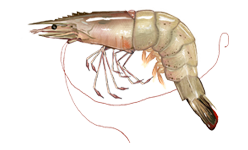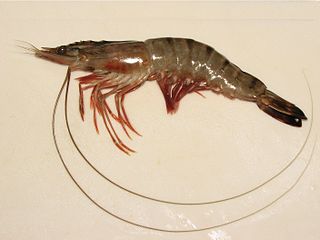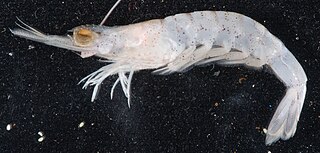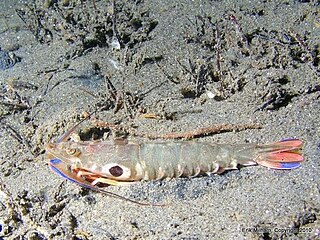
The Caridea, commonly known as caridean shrimp or true shrimp, from the Greek word καρίς, καρίδος, are an infraorder of shrimp within the order Decapoda. This infraorder contains all species of true shrimp. They are found widely around the world in both fresh and salt water. Many other animals with similar names – such as the mud shrimp of Axiidea and the boxer shrimp of Stenopodidea – are not true shrimp, but many have evolved features similar to true shrimp.

Dendrobranchiata is a suborder of decapods, commonly known as prawns. There are 540 extant species in seven families, and a fossil record extending back to the Devonian. They differ from related animals, such as Caridea and Stenopodidea, by the branching form of the gills and by the fact that they do not brood their eggs, but release them directly into the water. They may reach a length of over 330 millimetres (13 in) and a mass of 450 grams (1.0 lb), and are widely fished and farmed for human consumption.

Litopenaeus setiferus is a species of prawn found along the Atlantic coast of North America and in the Gulf of Mexico. It was the subject of the earliest shrimp fishery in the United States.

Penaeidae is a family of marine crustaceans in the suborder Dendrobranchiata, which are often referred to as penaeid shrimp or penaeid prawns. The Penaeidae contain many species of economic importance, such as the tiger prawn, whiteleg shrimp, Atlantic white shrimp, and Indian prawn. Many prawns are the subject of commercial fishery, and farming, both in marine settings, and in freshwater farms. Lateral line–like sense organs on the antennae have been reported in some species of Penaeidae. At 210 metres per second (760 km/h), the myelinated giant interneurons of pelagic penaeid shrimp have the world record for impulse conduction speed in any animal.

Penaeus is a genus of prawns, including the giant tiger prawn, the most important species of farmed crustacean worldwide. The genus has been reorganised following a proposition of Pérez Farfante and Kensley based on morphological differences, in particular the genital characteristics of these animals, although this revision has not been universally accepted. Following the revision, many species formerly in the genus Penaeus have been reassigned to new genera in the family Penaeidae: Farfantepenaeus, Fenneropenaeus, Litopenaeus, and Marsupenaeus. The following table gives an overview:
Farfantepenaeus notialis is a species of marine crustacean in the family Penaeidae.

Rimapenaeus is a genus of prawns. It comprises six species, including the "roughneck shrimp", Rimapenaeus constrictus:

Farfantepenaeus is a genus of prawns in the family Penaeidae. Its eight species were formerly included in the genus Penaeus. It was first published as a genus name in 1972 by Rudolf N. Burukovsky, but without the necessary designation of a type species. That situation was corrected by the same author in 1997. The name Farfantepenaeus commemorates the Cuban carcinologist Isabel Pérez Farfante.

Sicyonia is a genus of prawns, placed in its own family, Sicyoniidae. It differs from other prawns in that the last three pairs of its pleopods are uniramous, rather than biramous as seen in all other prawns.

Marsupenaeus is a monotypic genus of prawn. It contains a single species, Marsupenaeus japonicus, known as the kuruma shrimp, kuruma prawn, or Japanese tiger prawn. It occurs naturally in bays and seas of the Indo-West Pacific, but has also reached the Mediterranean Sea as a Lessepsian migrant. It is one of the largest species of prawns, and is accordingly one of the most economically important species in the family.
Isabel Pérez Farfante was a Cuban-born carcinologist. She was the first Cuban woman to receive her Ph.D. from an Ivy League school. She returned to Cuba from the United States only to be blacklisted by Fidel Castro's government. She and her family escaped Cuba, and she became one of the world's foremost zoologists studying prawns. She discovered large populations of shrimp off the coast of Cuba and published one of the most noted books on shrimps: "Penaeoid and Sergestoid Shrimps and Prawns of the World. Keys and Diagnoses for the Families and Genera."

Trachysalambria curvirostris is a species of prawn that lives in shallow waters of the Indo-West Pacific. It is one of the most important species targeted by prawn fishery, with annual harvests of more than 300,000 t, mostly landed in China.

Trachysalambria is a genus of prawns, containing ten species. It was erected in 1934 by Martin Burkenroad, as a subgenus of Trachypenaeus, with T. curvirostris as its type species. That subgenus was elevated to the rank of genus in 1997 by Isabel Pérez Farfante and Brian Kensley. The ten species are:

A shrimp is a crustacean with an elongated body and a primarily swimming mode of locomotion – typically belonging to the Caridea or Dendrobranchiata of the decapod order, although some crustaceans outside of this order are also referred to as "shrimp".

Farfantepenaeus aztecus is a species of marine penaeid shrimps found around the east coast of the US and Mexico. They are an important commercial species in the US. The FAO refers to them as the northern brown shrimp; other common names, used in the US, are brown shrimp, golden shrimp, red shrimp or redtail shrimp.
Sicyonia ingentis is a species of prawn in the family Sicyoniidae known by the common name ridgeback prawn. It is native to the eastern Pacific Ocean, where it occurs along the coast of California and Baja California, its distribution extending from Monterey Bay to Isla María Madre off Nayarit. It also lives in the Gulf of California. Other common names include Pacific rock shrimp and Japanese shrimp. In Spanish it is called camarón de piedra del Pacífico and cacahuete.

Aristeidae is a family of Dendrobranchiata decapod crustaceans known as deep-sea shrimps, gamba prawns or gamba shrimps. Some species are subject to commercial fisheries.
Metapenaeopsis commensalis is a species of crustacean in the family Penaeidae first described by Lancelot Alexander Borradaile in 1898.
Metapenaeopsis miersi is a crustacean species in the family Penaeidae described by Lipke Bijdeley Holthuis in 1952.

The eastern king prawn is an edible dendrobranch prawn endemic to eastern Australia. Its scientific name is Melicertus plebejus or Penaeus plebejus. It is caught by commercial and recreational fishers for human food.













